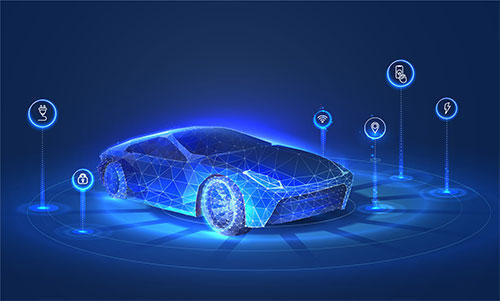Cars have rapidly evolved from simple transportation to complex, IoT devices. Connected cars today come with advanced features such as telematics, vehicle-to-everything (V2X) communication and high-tech infotainment systems, offering a customized and digitally enhanced driving experience. However, with the increasing intelligence of cars, cybercriminals have also become smarter. Just like smartphones and computers, connected cars are data-rich targets for cyberattacks, leaving them vulnerable to unauthorized surveillance, privacy violations and fraudulent activities. Recent incidents include hackers remotely controlling a Tesla using Wi-Fi and a drone, which could have potentially been weaponized as a worm1.
The rapid adoption of 5G technology and cloud-based Electronic/Electrical (E/E) architecture further expands an automobile’s attack surface. New vulnerabilities also arise as automobile manufacturers move over-the-air updates and third-party applications to Vehicle-to-Cloud (V2C) connectivity.
Automotive Cybersecurity From the Cloud to the Car
As an OT security provider, it’s essential to offer solutions that can manage complexity within automotive networks and provide complete protection across the entire attack surface—from the cloud to the car. This entails advanced threat detection capabilities that can perform dynamic analysis to identify unknown malware and zero-day threats, as well as a response mechanism for the network. It is also crucial to safeguard connected cars against the latest malware variants with proactive technologies that can block previously unknown threat variants. By doing so, the risk of data breaches or damage caused by mobile malware is significantly reduced. Leveraging advanced detection engines is also necessary to prevent new and evolving threats from gaining access to sensitive information within a network.
Connected cars contain a lot of data, which is stored in the car, the cloud and third-party services. To keep this data safe, it's crucial to have a security solution such as the Fortinet Security Fabric that provides complete visibility and control over the entire environment. This approach reduces security risks, simplifies troubleshooting and streamlines deployment. Additionally, it combines network and security, which offers predictable costs and eliminates the need to manage separate contracts.
Consider incorporating a system that provides real-time threat intelligence, like the one offered by Fortinet's FortiGuard Labs. This enables the vehicle to receive the latest vulnerability and threat information, ensuring sufficient and automated protection. Additionally, connecting to a cloud network allows for the sharing and correlation of events, leading to timely virtual security patches and updates.
Download our white paper, “How Fortinet Fortifies the Automotive Industry: Delivering Security for Automotive Security Providers” to learn more about Fortinet’s security solutions for connected cars:
1. Tesla Car Hacked Remotely From Drone Via Zero-Click Exploit

